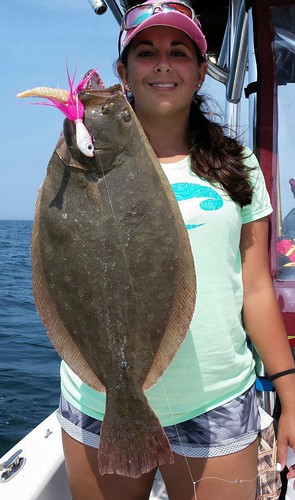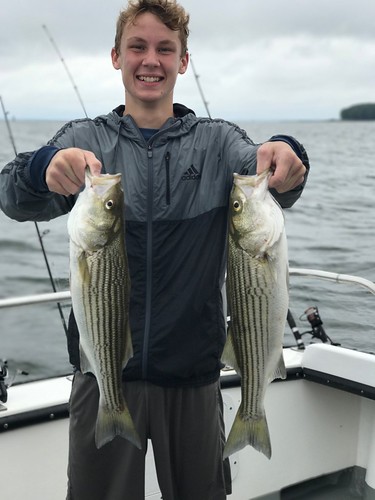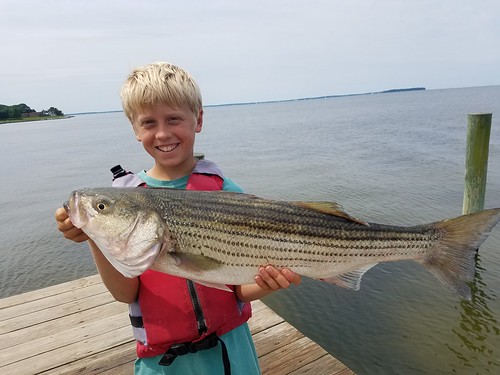Weekly Fishing Report: July 26

Anglers Daniel Irons (L) and Jonathan Irons (R); Photo by Mike Irons
As most of us know it was pretty darned hot last week and those hot temperatures are driving up water temperatures and having a profound effect on fish and fishing. Unfortunately those hot temperatures can also result in violent storm activity when a cool front comes through as it did Sunday. I happened to be able to witness the tornado devastation on Kent Island Monday morning and my heart goes out to those affected. I also noticed large patches of discolored water from runoff which does not help the fishing situation in the bay. This runoff may also impact your favorite impoundment, stream or river. Sound advice is to keep close watch on summer storm activity out on the water and wear those lifejackets, they don’t do any good stashed in a boat locker.
At the very top of the bay in the region of the lower Susquehanna River there continues to be early morning action in the Conowingo Dam pool for striped bass. Casting heavy swimshads has been popular but topwater lures have proven successful also. There are also some striped bass being caught in the boulder strewn areas of the river just below the dam pool. At the Susquehanna Flats area there is a topwater bite that is providing just enough action to have a few locals coming back for more. They report that smallmouth bass and largemouth bass are also part of the mix.
As we approach middle of summer, Maryland’s main bay surface and upper water column temperatures are in the low 80s (F) with numerous rivers showing higher water temperatures. Remember that larger striped bass prefer cooler water temperatures and will avoid temperature above 84 degrees F. Fortunately, there are lots of Maryland waters that have adequate oxygen from surface to bottom so the focus is on deeper waters that will provide best combination of cool water and adequate oxygen. Here are some tips for locating striped bass and an outlook on bay conditions over the next few days.
- Anglers may want to explore the Chesapeake Bay bridge area up to Rock Hall at depths down to about 30 feet. This area has the best combination of coolest water with adequate oxygen.
- The best fishing areas could be further refined by intersecting these prime areas with underwater points, drop-offs, large schools of baitfish and moving water.
- If present, avoid fishing in any large algal blooms.
- Some areas of poor water clarity could occur as a result of localized rainfall.
- Take advantage of the new moon July 23, 2017, for above average tidal currents and nighttime low light conditions through Thursday.
- Aside from some forecast precipitation Thursday and Friday, bay conditions should be relatively stable for the upcoming week.
For more detailed and up-to-date fishing conditions in your area of the bay, be sure to check out Eyes on the Bay’s Click Before You Cast. Since this is a new feature for Chesapeake Bay anglers, drop us a line with comments or suggestions.
Fishing for striped bass in the upper bay region continues to be good this week at several locations where chumming or live lining spot is taking place. Swan Point, the Love Point area (which includes the Triple Buoys), the Mud Flats and finally Podickory Point. Most are chumming or chunking with continued success along the channel edges at these locations but live lining spot is becoming increasing popular for those making the trip to the upper bay locations from middle bay region ports. Generally the same story unfolds this week; the larger striped bass are holding close to the bottom as long as there is oxygen down there and the smaller two and 3-year-old striped bass are higher in the water column. As surface water temperatures climb into the mid 80s the morning bite for larger fish is usually better. The new “Click Before You Cast” link from the Eyes on the Bay Program will help anglers understand where deeper and cooler waters have enough oxygen to hold the larger striped bass.
There continues to be some trolling action along the steeper channel edges of the shipping channel on the western side of the bay from Chesapeake Beach south. Inline weights or planers are needed to get lures down close to the bottom where fish are holding. Bucktails dressed with sassy shads or twistertails are a good bet as are surge tube lures.
Trolling is an option and a mix of red surge tube lures, bucktails dressed with sassy shads or twistertails and small spoons are common lures being used. All are being pulled behind inline weights or in the case of small spoons and medium-sized bucktails, planers can be used. Umbrella rigs are another option and often need heavy inline weights to get down to the fish. Jigging can be an option if suspended fish can be located along channel edges or under smaller breaking fish.
In the middle bay region breaking fish are being encountered at times and there has been some success with jigging under the surface action or trolling in the vicinity. As is usual the surface fish are two and 3-year-old striped bass and small bluefish are becoming more common in the mix this week. Metal jigs and large soft plastics have been popular for those jigging and small spoons, red surge tube lures and bucktails have been good trolling lures. Inline weights and planers are in order to help get trolling lures down to where the larger striped bass are holding.
Now that there are plenty of spot in the middle bay region on shoals and bars in the tidal rivers and bay edges live lining spot is a wonderful option. Slowly cruising along channel edges until suspended fish can be spotted and then live lining spot is a great option this week. Traditional locations like the Diamonds, the Hill, Thomas Point and Hackett’s are some of the first places to be checked.
The shallow water striped bass fishery has been steadily deteriorating as water temperatures in the shallows soar, it is just too warm for the striped bass over 20”. At times one can be lucky enough to encounter a few fish in the earliest hours of the morning before sun rise but cooler water temperatures are needed before this fishery revives itself. Even white perch are finding the shallows a bit toasty and the larger perch tend to be holding deeper now.
Bottom fishing for a mix of white perch, spot and a few croakers has been a fun option in the middle bay region this week. Hard bottom is one of first places to check and bloodworms are the bait of choice for spot, peeler crab or shrimp can also be a good option for white perch and croaker. If fishing from docks or other shoreline options, grass shrimp are a good bait as are small minnows.
In the lower bay region there is a wonderful mix of fishing options this week. Spanish mackerel are starting to be more common this week and they are mixing it up with bluefish and striped bass chasing bay anchovies. Trolling a mix of small spoons, red surge tubes (hoses) and bucktails have been what most are using in their trolling spreads. When targeting Spanish mackerel, small spoons behind inline weights or planers and kicking up the speed a bit goes a long way to success. Bluefish will also chase down those spoons and go for red surge tube lures (hoses).
Cobia are steadily becoming more common in the lower bay region around the Middle Grounds and the Target Ship areas. Smaller sized ones are showing up in chum slicks and the larger ones are being found often holding near buoys. Cobia will take cut bait in chum slicks and those targeting buoys are using live eels, live spot or large skirted soft plastic jigs.
Chumming for a mix of striped bass, bluefish and prized cobia has been very popular this week. The Buoy 72 area, the Middle Grounds, the lower Potomac, the Rock Piles and Point No Point Reef have been good places to look for striped bass to set up on. Bluefish and small striped bass tend to dominate chum slicks and small inshore sharks such as black tips are also being caught.
Jigging can be an option for striped bass when fish can be found suspended along channel edges this week. Some of the best striped bass action lately has been in the Potomac River above the Route 301 Bridge.
There continues to be good fishing for speckled trout on the eastern side of the bay along sedge marsh edges and small creeks running out of the marshes. Drifting peeler crab baits is always fun since such a wide variety of fish will take them. Speckled trout are of course the target but bluefish, striped bass, red drum, large white perch and even flounder have a hard time passing up a yummy bait like that. Unfortunately cow-nosed rays love the smell of crab also and will give a light tackle angler a run for his money.
Fishing for large spot has been extremely good in the lower bay region this week. The lower Patuxent River near the Hawks Nest and Hellen’s Bar area have been excellent places to fish with bloodworms on a bottom rig. White perch, kingfish and a few croaker are helping round out the mix. The lower Potomac around Ragged Point and the mouth of St. Mary’s River have been good places to fish. On the eastern side of the bay the Sands and Great Rock shoals are good places to fish and the spot should be moving into the Hooper’s Island area this week.
It is certainly no secret that hot summer weather is upon us and freshwater fish like us are looking for some relief from sweltering temperatures. In the western region of the state, fish at Deep Creek Lake are going as deep as possible as long as there is sufficient oxygen down there to breath. Cold water fish such as northern pike, walleye, yellow perch and trout are down deep and tend to stay down there for the duration. Smallmouth bass are a little more tolerant and will come into shallower areas to feed at night and can at times be found lazing under floating docks in the morning hours. Largemouth bass follow the same pattern but tend to stay in transition areas near structure or under floating docks and fallen tree tops to get away from the sun. Flipping whacky rigged soft plastics under structure providing shade or deeper sunken wood or rocks is a great option.
Trout in the western region will be also looking for shade from the sun and cool flowing water. Deep pools that are shaded by overhanging trees is a great place to start. Usually early mornings and late evenings are the best times to fish since most trout are actively feeding at night. Smallmouth bass in the upper Potomac tend to hold to the same pattern as warmer water temperatures prevail. Deep water current breaks, submerged ledges in deeper waters and large boulders are good places to target with tubes, topwater lures and crankbaits.
Largemouth bass fishing is solidly in a typical summer pattern of behavior. The bass are feeding at night in the shallower areas of lakes, ponds and tidal rivers and retreating to cool shade during the hotter day time hours. That shade can come in the form of overhead cover such as docks, fallen treetops or thick floating grass. Usually when they are holding in the shade they will subtily pick up baits such as whacky rigged stick worms that are enticingly dropped in front of them. Late in the evening or early morning hours will find them shallow and topwater lures are the ticket to some fun. Chatterbaits, buzzbaits, frogs and poppers are all good choices and watch out for northern snakeheads to get in on the action also.
At our coastal areas around Ocean City, surf fishing for a summer mix of kingfish, croaker, flounder and small bluefish has been good. The early morning and late evening hours tend to offer the best opportunities and an incoming tide helps up the odds. Bloodworms, sand fleas or small cut baits from spot are good choices for the kingfish. Squid will work well for flounder and croaker. Cut bait or finger mullet are the best options for bluefish.

Angelina Watts holds up a really nice flounder she caught at the subway car reef near the Jack Spot. Photo by Rich Watts
In and around the inlet and Route 50 Bridge fishing for sheepshead has been good when fishing tight to structure. Sand fleas tend to be the best option, but where opportunity presents itself, chumming with barnacles and slipping some on a hook can really put you on to some nice fishing. It takes some prep but a flat shovel is used to scrape them off pilings at low tide into a bucket, then you set up where you believe sheepshead may be holding.
Flounder are being caught in the inlet during the day on squid and some larger flounder are coming to net for those drifting live spot. At night bluefish and striped bass are being caught on cut bait, live spot or by casting swimshads and bucktails.
Flounder are holding in some of the back bay channels but finding legal sized flounder has been tough lately. Sinepuxent Bay and the area near the airport has been reported to be offering some of the better fishing lately.
Outside the inlet, flounder are being found on some of the nearshore shoal areas and out at the wreck and reef sites. Larger flounder help round out a day’s catch near the wreck and reef sites for those fishing for sea bass. Those that specifically target flounder at these sites often do well.
The 20 Fathom lumps along the 30 Fathom line have been great places to chunk for a nice grade of yellowfin tuna this week. Massey’s has also been providing good chunking opportunities, chicken dolphin can be part of the mix. There has also been some good trolling action in this area for yellowfin tuna, gaffer dolphin, white marlin and wahoo.
Out at the offshore canyons, there is a mix of yellowfin tuna, wahoo, dolphin and blue and white marlin being caught. There is also some excellent deep drop fishing on the inside edges of the canyon shelves for a mix of large sea bass and two species of tilefish.
“Everything about him was old except his eyes and they were the same color as the sea and were cheerful and undefeated.” -Ernest Hemingway, The Old Man and the Sea
 ABOUT THE AUTHOR Keith Lockwood has been writing the Fishing Report since 2003 and has had a long career as a fisheries research biologist since 1973. Over the course of his career he has studied estuarine fishery populations, ocean species, and over a decade long study of bioaccumulation of chemicals in aquatic species in New Jersey. Upon moving to Oxford on the eastern shore of Maryland; research endeavors focused on a variety of catch and release studies as well as other fisheries related research at the Cooperative Oxford Laboratory. Education and outreach to the fishing public has always been an important component to the mission of these studies. Keith is an avid outdoorsman enjoying hunting, fishing, bird dogs, family and life on the eastern shore of Maryland.
ABOUT THE AUTHOR Keith Lockwood has been writing the Fishing Report since 2003 and has had a long career as a fisheries research biologist since 1973. Over the course of his career he has studied estuarine fishery populations, ocean species, and over a decade long study of bioaccumulation of chemicals in aquatic species in New Jersey. Upon moving to Oxford on the eastern shore of Maryland; research endeavors focused on a variety of catch and release studies as well as other fisheries related research at the Cooperative Oxford Laboratory. Education and outreach to the fishing public has always been an important component to the mission of these studies. Keith is an avid outdoorsman enjoying hunting, fishing, bird dogs, family and life on the eastern shore of Maryland.
Want the Weekly Fishing Report sent right to your inbox? Click here to sign up!


